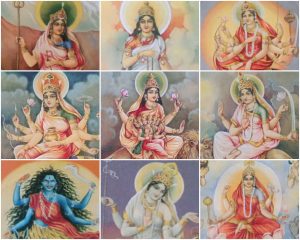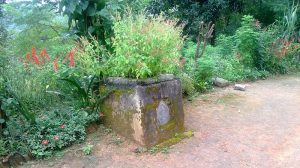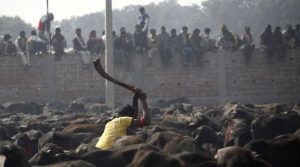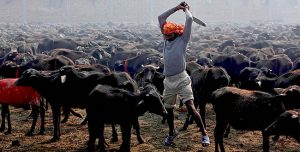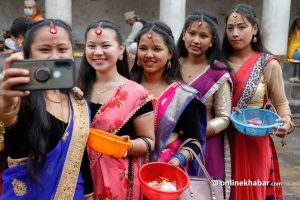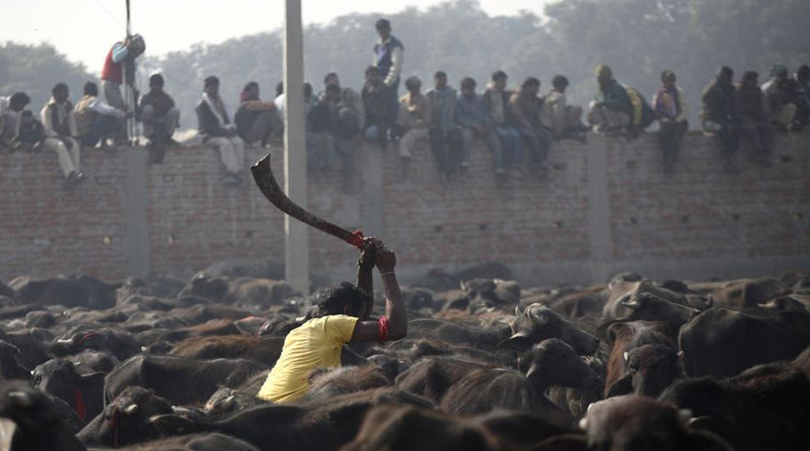
The year: 2014. The day: November 24.
Despite a massive global media furor and campaigns including stage protests, impassioned pleas, urgent petitioning, vocal dissents and vehement denunciations–the day marked the beginning of a month-long—the ‘largest’, ‘bloodiest’, ‘cruelest’, ‘goriest’, and ‘most barbaric’ animal sacrifice in the world at a Hindu shrine called Gadhimai in a small nondescript village called Bariyarpur in Bara district, 150 km southeast of Kathmandu.
This ritualistic mass slaughter of animals was carried out to supposedly propitiate the Gadhimai Goddess Bhagwati for more than two and a half centuries (almost 265 years). In 2009 alone, tens of thousands of animals (an estimated 500,000 animals) including buffaloes, goats, chickens, ducks, pigeons and others were sacrificed.
In late July, 2015, the world seemed to suddenly fall silent …and … relieved, when a news, “Victory! Animal Sacrifice Banned at Nepal’s Gadhimai Festival, Half a Million Animals Saved”, a press release from Humane Society International (HSI) and Animal Welfare Network Nepal (AWNN) hogged the headlines in papers.
“We have decided to completely stop the practice of animal sacrifice,” was the statement made by Motilal Prasad, secretary of the Gadhimai Temple Trust, which organises the celebrations.
A pilgrimage to the Gadhimai
In 2013, my wife and I on a visit to Birgunj decided to make a trip to the famed Gadhimai temple located some 21-22km east of the bustling border town. We started early in the morning.
As we left Birgunj, the city seemed to gear up for the hectic day ahead. Whiffs of cooking wafted in through our car window. People crowded the teahouses for nasta (breakfast) as shopkeepers ladled out golden crisp jalebis on trays from huge karais (iron saucepans) at their shop fronts. A typical Terai teahouse morning nasta includes hot puris(fried flat bread), jalebis (sweets), potato curry and sweet tea–my favourite.
As we drove due east, miles after staggering miles of endless cultivated land stretched out, as far as we could see. And the smell – there was no mistaking the typical Terai hallmark—the strong odour of burning dead leaves and dung-cakes, followed by a pungent aroma of molasses.
Clusters of tiny farmsteads and clumps of mangos, the evergreen jamun and coconut trees dotted the distant fields. Mixed roadside settlements: ramshackle mud-and-thatch huts, improved brick houses, and makeshift lean-tos serving as shops and tea houses, flanked the highway on two sides.
Trundling bullock carts, piled high with hay, tractors plowing the distant fields, women going about their ways loads balanced on their head, men and women alike pedalling along on their bicycles, and the far-off intermittent hooting sound from a rice mill blended in to complete the Terai landscape. Radhika, my wife, was especially amused by the sight of so many men in dhotis, a rarity in Kathmandu.
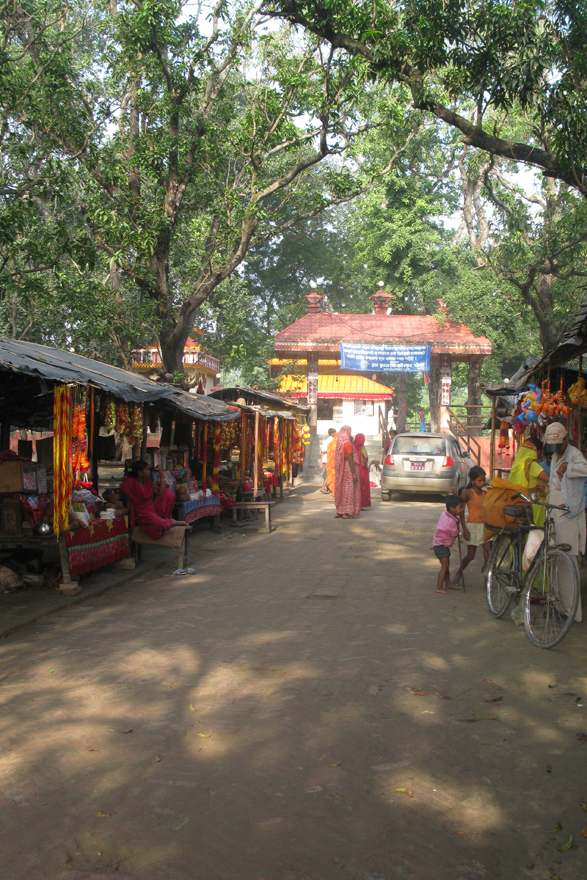
After travelling 13 km, we arrived in the bustling town of Kalaiya. The traffic crawled as we weaved through the congestion. While people milled about the haphazard clutter of shops, hawkers peddled their wares amid blaring loudspeakers belting out Hindi cinema tunes.
Motorcycles zipped past, and bicycles danced by and the tangas (horse-drawn two-wheeled vehicle) squeezed through – too close for comfort. I almost rammed into an ox-cart that suddenly appeared from nowhere. Adding more incongruity to the situation, doleful looking buffaloes squatted on the main street, masticating indifferently to the frenetic activity around them.
The Goddess and the myths
After kicking up dust across an 8-km dirt road, we finally arrived in Bariyarpur – one of countless impoverished villages in the Nepali Tarai. Soon, we were at the Gadhimai temple complex. A long row of lean-tos selling puja items lined the entrance lane. A flight of steps led to a large fore-court laid with noticeably clean flagstones.
Two small brightly painted pagoda styled temples stood side by side while banyan and pipal trees stood sentinels with their huge outstretched branches. Lucky for us, the post-Dashain time had not drawn a big crowd—and the main pujari (priest), Shiva Chaudhary Tharu, was readily available.
Soon, our puja began at the first temple. Completely bare of idols, a trident, said to be the spot where Gadhimai took up her residence first in Bariyarpur, stood beside a big stone (used for breaking coconuts).
The next temple housed the Gadhimai’s incarnate form. Inside the narrow interior, a well-carved polished jet-black stone idol of Gadhimai under the extended hood of a stone shesh-nag (a thousand-headed cobra) stood on a red lotus. Smothered in vermilion, and donning a red blouse, red sari, red shawl embroidered with a golden floral motif, the goddess sported a crown, nose ring, earrings, gold bangles and silver anklets.
If the Goddess’s one hand held a khadga (scimitar), the other carried a bajra (thunderbolt, symbolising a weapon used by Hindu deities). What were most striking were her eyes, large and cast in silver. Also venerated as Bhagwati Shree Gadhimai, the shrine is united with shakti peeths (holy places of cosmic powers). With a little pushing and shoving and the cracking of a coconut, our puja (worship ritual) sans the animal sacrifice (my wife and I do not observe animal sacrifice) was over.
Next, the chief pujari (priest), Chaudhary showed us around the temple complex. A big pond boasted the west of the temple where the devotees took a dip before their puja. The worshippers made it a point to pay homage to the Baba Kaleswornath temple and the Janginut deity located at two corners of the pond, the latter said to be Gadhimai’s sentinel.
Back at the temple, we observed people collecting soil from the bed of a tree. “Blessed by the Gadhimai, the soil from these tree beds is considered sacred, which if sprinkled in the fields enriches fertility of the land,” said Chaudhary. People also took the soil to sprinkle it in the foundation of their new houses.
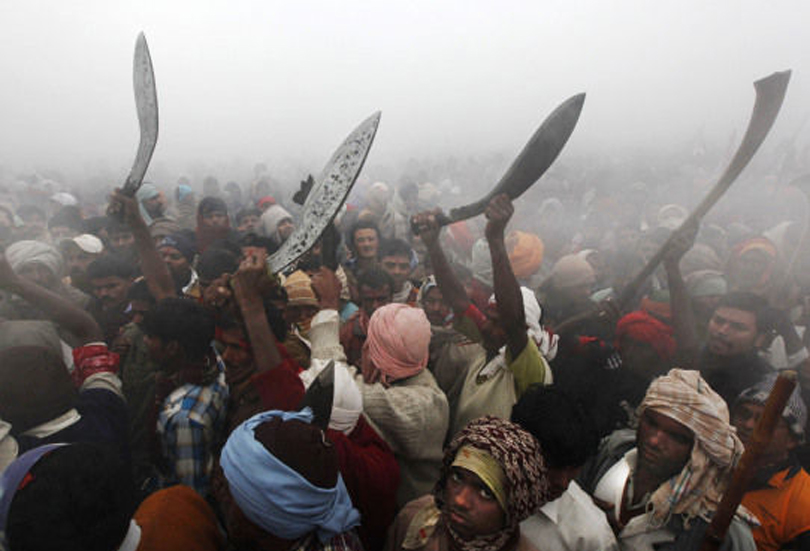
Ancient history
It is no surprise that every shrine in Nepal is shrouded in ancient myths, legends and religious beliefs. Gadhimai’s mystical history dates back some 900 years to a simple god-fearing and benevolent resident of Bariyarpur, named Bhagwan Chaudhary.
The story goes thus: One day a theft took place at Bhagwan Choudhary’s house, but the thieves were caught red-handed and paid with their lives at the hands of the enraged villagers. Fearing that his fellow villagers would be convicted, Bhagwan Chaudhary took the blame himself and was sent to Nakkhu jail in Kathmandu.
One night, the goddess of Makawanpur Gadhi appeared in his dream and kept appearing on subsequent nights asking her to take him to Bariyarpur and the scene of the crime. The goddess’s occult powers freed Bhagwan Chaudhary from the jailhouse, and a pinch of soil from her feet to his turban enabled him a free passage back to his village.
In return, Gadhimai asked him to sacrifice five humans each year. Bhagwan Chaudhary magnanimously offered his own life, saying he would be unable to perform human sacrifice. Instead he vowed an animal pancha bali (a quintuple sacrifice) every five years. It would include a rat, a pig, a rooster, a goat and a water buffalo.
And thus began the tradition of an animal pancha bali to appease Gadhimai, the goddess of power and prosperity, and a guardian against evil. This ritual failed, however, as children and youngsters of Bariyarpur suddenly took ill and started dying.
Bhagwan Chaudhary again made an appeal to Gadhimai and was directed by the goddess to offer a human sacrifice along with the pancha bali. The hunt began for a human, but to no avail. Fortunately, a villager from Simri from neighbouring Rautahat district came to the rescue and instead of his life, offered as sacrifice, shedding of five drops of blood from his body—the chest, tongue, lower part of eye, thigh and arm. Miraculously, that averted the calamity.
“This ritual is practiced at every five-yearly mela (fair),” said Chaudhary as he wound up his brief history of Gadhimai.
Chaudhary, a direct descendant of Bhagwan Chaudhary, has also authored a booklet on Gadhimai in Hindi. In fact, the positions of chief priest and others at Gadhimai are all hereditary, passed on to the descendants of Bhagwan Chaudhary.
The mela (fair)
“Every five years, Bariyarpur buzzes from dawn till dusk for an entire month. The turnout of devotees is massive. It crosses the five million mark, out of which almost 75 per cent belong to bordering towns in Uttar Pradesh and Bihar in India,” a local, Manoj Chaudhary, informed me.
Like a river in spate, a constant stream of people keep pouring in, pushing and shoving here, there and everywhere with hardly any elbow room. Devotees in hordes are seen camping out in the open with their kitchens set outdoors. Makeshift stalls by the hundreds are squeezed together around the temple grounds occupying every inch of empty space available.
From sugary sweets to bangles, puja items to local souvenirs, the shops and eateries do brisk business and the festive atmosphere resonates with blaring loudspeakers playing Hindi bhajans.
Next, and with a tremendous sense of awe, we visited the site where the massive sacrifices were carried out. According to the Hindu lunar calendar, on the second Saptami of Mangsir (second or third week of November), the seventh day of the full moon, the chief priest offers puja to Gadhimai at the Bramha Baba shrine located under a huge pipal tree.
A ghee-lamp spontaneously and miraculously lights itself, the miracle said to be brought about by Gadhimai’s visit to this shrine, where the goddess resides all through the month-long mela. The narabali (human sacrifice) of five drops of human blood and the animal pancha bali is initiated. The mass sacrificial ritual follows, carried out in a walled-in ground near the temple. Only licensed persons designated by the mela committee carry out the sacrifice.
The lamp goes off on its own on the day the mela ends and Gadhimai returns to her usual place. The bali (sacrifice) is halted immediately and the remaining buffaloes are herded off earmarked for the next mela with the tips of their ears chopped off.
Save for some stray donkeys grazing on the lush grass, the sacrificial ground (walled with an area of 1 bigha), which becomes a seething mass of slaughtered animals on the day the festival begins, wore a deserted look. I stood there trying to visualise the gory scene when men wielding swords and machetes decapitated the buffaloes … in thousands.
For my wife and me, the Gadhimai pilgrimage was a profound experience, evoking awe, wonder and a mix of emotions. There was a certain mystique about the shrine – its overpowering presence, history, and above all its timeless religious practice and tradition.




